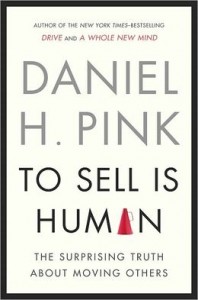By Rose O. Sherman, EdD, RN, FAAN
“We’re All in Sales Now – Some 1 in 9 workers still earn a living in traditional sales. The other 8 in 9 are engaged in “non-sales selling.” We devote upward of 40 percent of our time on the job to moving others.” Daniel Pink
Most nurse leaders would probably not consider themselves to be in sales. Daniel Pink in his new highly engaging new book, To Sell is Human, would argue otherwise. He would describe the nurse leader role as non-sales selling. If you are in a role like that of a leader and it involves persuasion, then you are in sales whether you directly sell products, participate in teamwork efforts or attempt to direct the behavior of others. You are essentially persuading, convincing, and influencing others to give up something they’ve got in exchange for what you may need them to do. In this book, he offers some important insights in how you can become more effective in your efforts to motivate others.
Some Key Ideas in the Book
With the advent of the Internet, our staff often have access to as much information as we do about changes in the environment. Pink advises that the leader “seller” is no longer protector and purveyor of information but rather the curator and clarifier of it—helping staff to make sense of the blizzard of facts, data, and options. To sell effectively in this environment, honesty, fairness, and transparency are the only viable path. He also suggests that the most effective way to move others is to what he describes as “problem find” or uncover challenges they may not know they have. Your goal in selling is not to deprive the person but hopefully leave he or she better off in the end. To move people a large distance and for the long term, we have to create the conditions where they can move themselves. It means trying to elicit from people what their goals are for themselves and having the flexibility to frame what we do in that context.
The Qualities Needed to Sell Today
In his book, Pink presents a wide range of social science research on the art of selling. Three qualities emerged as being important to be effective in moving others. These qualities are attunement, buoyancy, and clarity.
1. Attunement is the ability to bring one’s actions and outlook into harmony with other people and with the context you’re in. It is the ability to understand the perspective of another and look at situations through their eyes. It means trying hard to understand their biases and preferences. Research indicates that syncing our mannerisms and vocal patterns to someone else is fundamental to the attunement needed to motivate the behavior of others. People are more likely to move together when they share common ground so looking for the common ground is important.
2. Buoyancy is the ability to stay afloat in a sea of rejection. Staying optimistic and positive even in the face of difficulty making a connection is critical. Pink contends that the effects of positivity during a encounter designed to influence another makes the other person less adversarial and more open to possibilities and perhaps a willingness to reach an agreement in which both parties benefit.
3. Clarity is the ability to hypothesize and to clarify what’s going to happen next. To effectively do this, you must be good at asking questions—uncovering possibilities, surfacing latent issues, and finding unexpected problems. Pink also suggests that clarity depends on contrast. Staff will often understand something better when they see it in comparison with something else than when they see it in isolation. The research has shown that too many choices is often not a good thing. Framing people’s options in a way that restricts their choices can help them see those choices more clearly instead of overwhelming them. People derive much greater satisfaction from purchasing experiences than they do from purchasing goods so emphasizing the value of an experience can help in influencing the behavior of another. Questions have also been shown to outperform statements in persuading others. Through questions, people can come up with their own reasons for agreeing or not agreeing to what they are being asked to do.
Pink advises that timing can be a major factor in your ability to influence others – sometimes waiting can be helpful. He also recommends that servant leadership is the most effective approach for motivating others in the long run. It begins with the idea that those who move others aren’t manipulators but servants. So the next time you find yourself in a positive of trying to motivate another – remember that to sell is human and there are strategies to be more effective in your efforts.
Read to Lead
Pink, Daniel H. (2012). To Sell is Human: The Surprising Truth about Moving Others. New York: Riverhead Books
[amazon asin=1594487154&template=iframe image&chan=default]
© emergingrnleader.com 2013



 LinkedIn
LinkedIn Instagram
Instagram